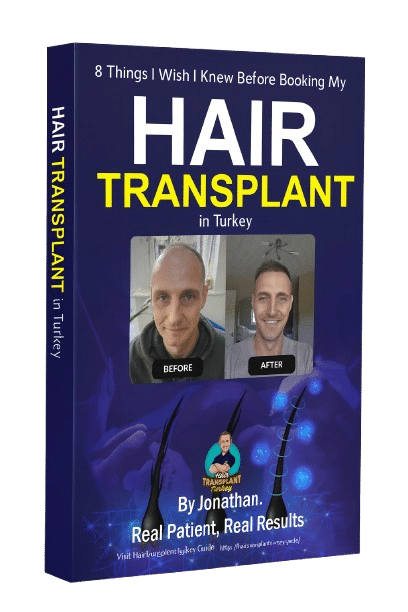If you’re like I was before my procedure, one of your biggest fears is probably ending up with a “pluggy” or fake-looking hairline. That overly straight, dense, and doll-like appearance was common decades ago when older methods used large grafts and poor placement. The good news is that modern techniques — when done correctly — produce results that are completely natural.
I know, because I had my own FUE hair transplant at Clinicana Hair Transplant & Esthetic Surgeries in Istanbul, and the outcome has been far beyond what I expected. In this article, I’ll explain exactly what makes the difference between natural and unnatural results — from consultation to aftercare — and how you can avoid common mistakes.
If you haven’t yet, I’d recommend grabbing my free guide, “8 Things I Wish I Knew Before Booking My Hair Transplant in Turkey”, where I go into even more detail about what to look for before you commit.
Understanding What Makes Hair Look Natural
A natural-looking hair transplant isn’t just about density. It’s about direction, angle, placement, and irregularity — because real hairlines are never perfectly straight or uniform.
Older procedures used large 3–4 mm punch grafts, which left that “plug” effect. Modern techniques like FUE (Follicular Unit Extraction) and DHI (Direct Hair Implantation) extract and implant individual follicular units of one to four hairs each. This allows for subtle blending and soft gradients, especially around the frontal hairline.
The International Society of Hair Restoration Surgery (ISHRS) explains that a properly designed hairline should follow natural scalp patterns with a soft transition zone, especially for male patients who want age-appropriate results.

Clinicana followed this principle carefully in my case. My surgeon, Dr. Soner Tatlıdede, spent a good half-hour marking out my hairline with a pencil, showing me how it would blend into my existing density. That initial design meeting was one of the biggest factors in the final result — it wasn’t rushed, and every follicle direction was discussed.
Once you understand what makes hair look real, the next step is choosing the right technique and surgeon to achieve it.
The Consultation: Where a Natural Result Begins
A lot of people underestimate the importance of the consultation. This is where your entire result is planned. The goal isn’t just to add hair — it’s to create the illusion of fullness while keeping your natural hair characteristics.
At Clinicana, my consultation was incredibly thorough. My face shape, age, and donor density were all considered. The surgeon explained why a slightly higher and irregular hairline would look more realistic for me than a perfectly straight one. That level of honesty gave me confidence I was in good hands.
Here’s what to look for in a clinic consultation:
| Key Factor | Why It Matters |
|---|---|
| Individual design | Prevents uniform, fake results. |
| Surgeon involvement | The surgeon, not just technicians, should mark your hairline. |
| Realistic density planning | Avoids overharvesting and maintains donor area health. |
According to the Mayo Clinic’s guide on hair transplantation, planning the angle and density of transplanted hair is what ultimately determines how natural your results appear.
Once your design is agreed, the next big factor is the surgical method used.
The Procedure: Precision Matters More Than Quantity
The day of my transplant at Clinicana was a long one — about seven hours — but it was done with meticulous care. My team extracted grafts one by one using a micro-motor punch, a hallmark of the FUE method. Each follicle was examined before implantation, ensuring the correct grouping (single hairs for the front, doubles/triples for density behind).
The difference between a natural and unnatural result often comes down to angle and direction. Hair doesn’t grow straight up from the scalp — it grows at around 35–45 degrees and changes direction depending on the area. The Clinicana team paid attention to this detail, which made all the difference in my outcome.
A PubMed study on FUE success rates found that up to 85% of transplanted grafts survive after 12 months when handled correctly, leading to a 90% satisfaction rate. My results mirror that exactly — by month seven, my new hairline was indistinguishable from natural growth.
But even perfect implantation needs careful aftercare to stay that way.
Recovery and Aftercare: Protecting Your Natural Look
The healing process is where many people unknowingly damage their grafts. Proper aftercare is just as important as the surgery itself.
Clinicana made this easy by giving me step-by-step washing instructions and checking in via WhatsApp during the first week. They even performed my first post-op wash at the clinic. I learned not to touch or scratch the grafts, and to sleep with my head elevated to prevent swelling.
The British Association of Dermatologists highlights that newly transplanted follicles are fragile and need around two weeks to anchor properly. Even something as simple as wearing a tight hat too soon can affect growth direction.
By the second week, most of my scabs had fallen off naturally. By month three, I saw thin sprouts coming through — and by month seven, my density and direction were so natural that even my barber didn’t realize I’d had a transplant.
Once your new hair starts growing, the goal is to maintain and enhance it long-term.
Long-Term Care: Keeping Your Hairline Natural Over Time
Getting natural results isn’t just about surgery day — it’s about what you do afterward. I took Clinicana’s recommended hair growth supplements for a few months post-surgery, which helped strengthen the new follicles.
It’s also important not to overharvest your donor area. A good clinic will always protect it, ensuring the back of your head still looks full.
For ongoing care, I now:
- Use mild, sulfate-free shampoo
- Avoid heavy styling products
- Focus on protein and vitamin-rich nutrition
According to the European Academy of Dermatology and Venereology (EADV), long-term scalp health and balanced nutrition both support stronger hair regrowth and retention.
Even with all that, one of the most overlooked factors in natural-looking results is simply expectation management.
Avoiding Common Mistakes and Unrealistic Expectations
When I was researching clinics before booking, I came across many horror stories — people who went for the cheapest option, only to end up with a harsh, artificial hairline. From what I learned, most of these issues came down to:
- Poor planning or no surgeon involvement.
- Straight, unnatural hairlines designed by non-medical staff.
- Using the same graft type everywhere instead of mixing single and multi-hair units.
- Ignoring post-op care instructions.
The World Health Organization’s guide to medical tourism recommends that international patients verify clinic licensing, hygiene standards, and surgical supervision before traveling abroad. Clinicana operates inside Acıbadem Taksim Hospital, which is a fully accredited medical facility regulated by the Turkish Ministry of Health — that gave me real peace of mind.
Next, let’s look at how to find a clinic capable of consistently producing natural results.
How to Choose the Right Clinic for Natural Results
The best clinics share a few key traits — and these are exactly what I looked for before deciding on Clinicana:
| Clinic Factor | What to Check |
|---|---|
| Medical credentials | Confirm surgeon’s certification and experience. |
| Location | Choose a hospital-based clinic over a standalone shop. |
| Before & after portfolio | Look for soft, irregular hairlines and donor preservation. |
| Transparency | Packages should clearly list what’s included. |
| Language support | Communication matters, especially for international patients. |
Clinicana checked all these boxes. They had over 5,500 verified reviews, clear pricing (€2,850 for the standard package), and flawless organization from airport pickup to hotel stay. I never once felt unsure about what was happening.
After seven months, I can confidently say that the naturalness of my result came from those early choices — not luck.
My Honest Thoughts After Seven Months
It’s been months since my surgery, and I still find myself surprised when I look in the mirror. My hairline feels like mine — not something that was created. That’s the biggest compliment a transplant can receive.
The most important thing I learned? Natural results come from realistic goals, skilled surgeons, and disciplined aftercare.
If you’re considering a transplant, take your time researching and never choose purely on price. The right clinic — and the right team — makes all the difference.
If you’d like to learn more about what I wish I’d known earlier, get my free guide here: 8 Things I Wish I Knew Before Booking My Hair Transplant in Turkey. It’s completely free and walks you through everything I learned before, during, and after my experience in Istanbul.



 Continue with Google
Continue with Google